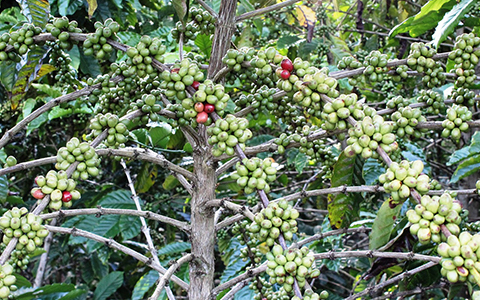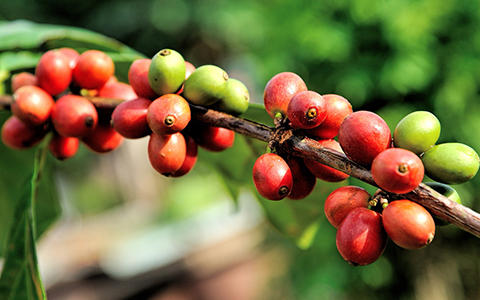Notice: Undefined variable: page in /home/vrxdg1855sn3/public_html/wp-content/themes/72tree/content.php on line 15
Notice: Trying to get property 'ID' of non-object in /home/vrxdg1855sn3/public_html/wp-content/themes/72tree/content.php on line 15
Growing Coffee Trees in Alpharetta Georgia

Skip planting coffee trees in Alpharetta, Georgia for them to only wilt and die. Knowing how and where to plant your coffee trees in Alpharetta, GA will give you a specimen tree worthy of years of conversation and appreciation.
72tree.com gathered the following species and growing information to help you plant, grow, and protect beautiful coffee trees in your yard or garden.
Is Coffee a Plant, Shrub, or Tree?
That depends on how you choose to grow them. Coffee plants are woody evergreens that can grow up to 6 feet and can be groomed to grow as large, sprawling bushes, or as short, robust trees.
Coffee Tree Information
Coffee (Coffea) is a genus of more than 120 species of flowering plants in the Rubiaceae family, mostly native to tropical Africa. Four species are primary coffee sources grown throughout the “coffee belt;” they include Arabica, Robusta, Excelsa, and Liberica. When growing coffee in Alpharetta, Georgia, consider the following species requirements:
Soil Requirement – A healthy coffee plant requires nutrient-rich, well-drained, and acidic soil. The soil also needs to be maintained at a pH level between 4.9–5.6. At these pH levels, the plant can better absorb nutrients, resulting in more coffee cherries and fewer pest or disease-related issues.
Sun Preference – This is a species of understory plants and will not thrive in direct, harsh sunlight. Coffee plants that are exposed to too much sunlight will develop chlorosis and leaf browning.
Water Requirement – Coffee plants need to be watered regularly and will droop when they are under-watered. Keep the soil moist without letting the roots sit in water.
Spacing – Place individual plants 8 feet apart to create a hedge and further apart if you plan on harvesting the beans. You’ll need to leave sufficient room to freely walk around each plant.
Hardiness Zone – Coffee trees are cold hardy to zones 10 and 11 (the Coffee Belt) but can be grown in zones 7 through 9 with proper care and protection in the colder months.
Winter Protection – This species is not frost-tolerant, so freezing temperatures are detrimental to your plant. A coffee tree exposed to temperatures below 30° F (1° C) easily dies. It is better to move the plant indoors (when grown in containers) or well-sheltered or wrapped when grown in the yard or garden.
Harvest Time – Harvest your coffee cherries from October through December. However, depending on the species and weather conditions, you may be treated to a second crop, harvested from April through June.
Note: Proper care will help you maintain and even increase your tree’s output over the years, depending on the variety. The average mature coffee tree can produce 10 pounds of coffee cherries or 2 pounds of beans annually.
Tip: Since coffee trees are so sensitive to colder weather, you may find greater success growing them in containers. This way, when cold or freezing weather approaches, your coffee trees can be moved to a greenhouse, garage, or indoors until warmer weather returns.
How to Process Coffee at Home
Harvesting, processing, and brewing your own coffee beans leaves you in absolute control of the quality, purity, and flavor of your home-grown coffee. The following steps will help you properly harvest, prepare, and brew coffee at home.

Step 1 – Pick ripe coffee cherries – Coffee cherries should be picked at their ripest when they have a dark-red exterior. This allows time for the fruit’s sugars to ferment, resulting in a deep, complex, and sweet cup of coffee when the seeds are roasted.
Step 2 – Remove the beans from the fruit – Soaking the harvested beans in water overnight will loosen the fruit from the bean, facilitating the bean’s removal.
Step 3 – Soak the beans in water for 48 hours – This step will help remove the slimy covering on your beans. They’re ready when they feel rough between your fingers instead of slick. Rinse them off and proceed to the next step.
Step 4 – Thoroughly dry the beans – This step is crucial if you intend to store the beans for any time and prevent mold. Spread the beans out on a flat surface and allow them to sun dry for 2 to 4 days. (If you intend to brew them immediately, skip this step and proceed to step 5).
Step 5 – Removing the parchment from your beans – The parchment is a naturally occurring, papery substance surrounding coffee beans (just like the membrane-like layer enveloping other fruit seeds). Hulling away the parchment is optional since some coffee beans are sold “in parchment” (or “en pergamino”). It depends on your preference.
Step 6 – Roast your beans – You can roast your coffee beans in a stainless steel skillet or pot over medium heat, bake the beans in the oven, or even roast them in an air fryer. Any way you choose, use medium heat, stirring frequently, and avoid burning them.
Step 7 – Grind and brew your coffee – Grind your roasted beans to your preferred coarseness and brew your homemade coffee how you like it.
Note: Traditionally, coffee is harvested by hand in one of two ways: strip picking or selective picking. Strip picking is exactly how it sounds, trees are harvested, “stripping” all the beans from the branches, ripened and unripened cherries. Selective picking is more time-consuming but allows you to harvest only ripe coffee cherries.
Growing Coffee in Alpharetta, Georgia
In this article, you discovered species, growing, and harvesting information to help you grow and cultivate the coffea species in Alpharetta, Georgia.
Properly caring for and protecting your coffee trees can provide your landscape with a unique fruiting plant species that can keep you well-supplied with coffee to grind.
Being ignorant to coffee tree planting and care requirements will lead to their eventual decline and death.
Sources:
blogs.ifas.ufl.edu/charlotteco/2019/06/05/coffee-a-great-ornamental-small-tree-and-maybe-a-bean-or-two/
plants.ces.ncsu.edu/plants/coffea-arabica/
edis.ifas.ufl.edu/publication/HS306
